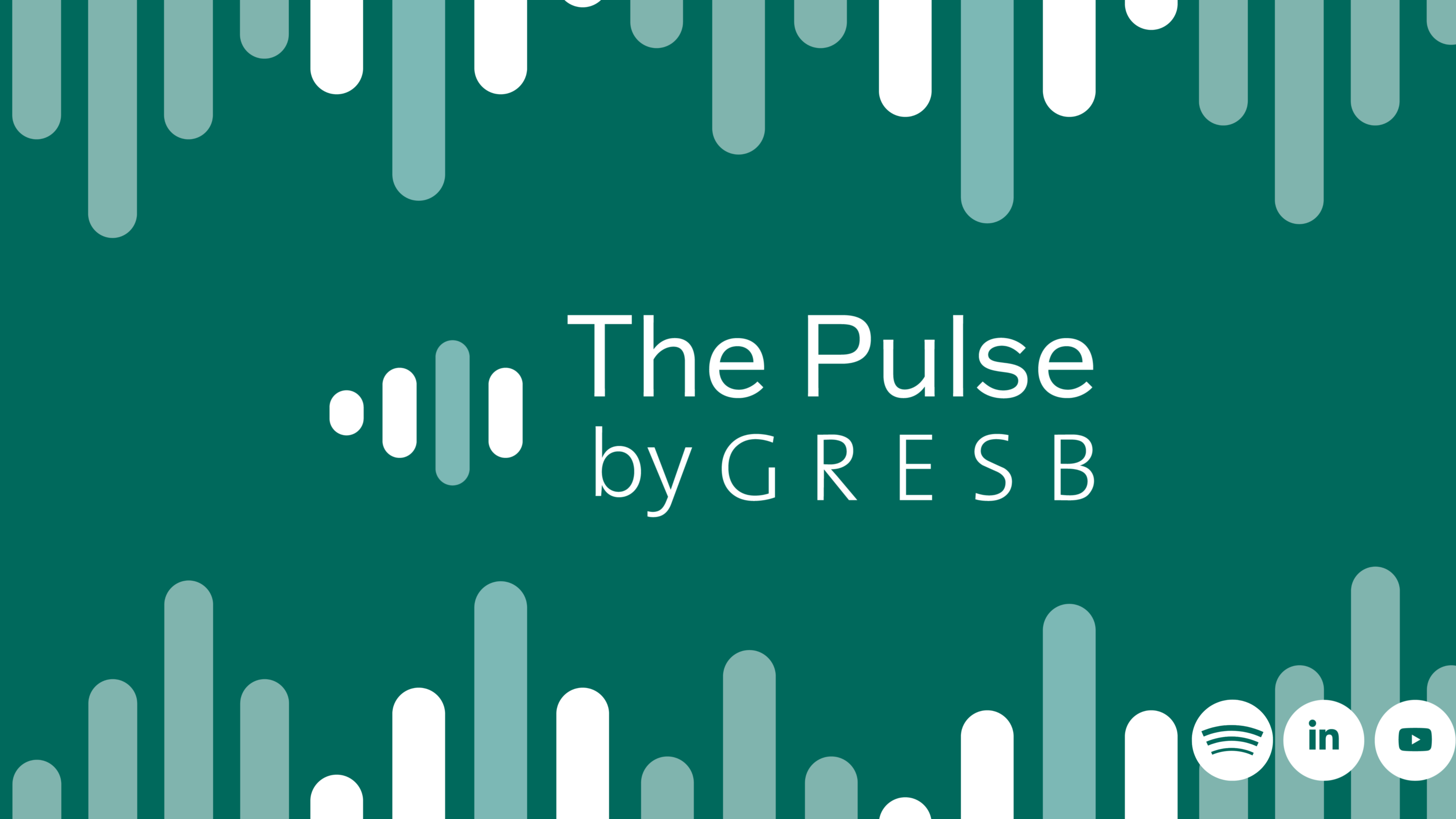
Introducing The Pulse by GRESB
The Pulse by GRESB is a new content series featuring the GRESB team, partners, GRESB Foundation members, and other experts. Each episode features a host from GRESB and at least one interviewee, focusing on an important topic related to either GRESB, ESG issues within real assets industry, decarbonization efforts, or the wider market.
Building for tomorrow: Dynamic materiality in infrastructure development
For this episode of The Pulse by GRESB, we are bringing you a conversation about GRESB’s new Development Asset Assessment. The Assessment aims to address the specific needs of infrastructure assets in the pre-operational phase, considering the growing demand for sustainable infrastructure globally. Featuring dynamic materiality, the Assessment adapts to the unique challenges of both the pre-construction and construction phases. It provides fund managers and investors with a comprehensive tool to track progress, ensuring alignment with ESG strategies and offering new opportunities for monitoring and improving sustainability practices.
Watch the episode below, featuring:
Transcript
Can’t listen? Read the full transcript below. Please note that edits have been made for readability.
Cathy Granneman: Welcome everybody to the fourth episode of The Pulse by GRESB. My name is Cathy Granneman. I’m a manager on the Member Relations Team at GRESB, and I’m joined today by Joss Blamire who is a Director in our Product Team for Infrastructure. Joss, welcome.
Joss Blamire: Good to be here.
Cathy Granneman: Great! I’m going to ask you a couple of questions about this new Development Asset Assessment that your team has been working on over the last year. And so, first question, very straightforward: why? Why are we having a new assessment?
Joss Blamire: Yes, that is a good place to start. Thanks, Cathy. The team has been working on this for about 18 months now, and we’re looking forward to launching on April 1. The reason why is fairly simple. We know that, in terms of the infrastructure market, a large portion of that market is [composed of] assets in the development phase, so pre-operational infrastructure assets.
Even from our own membership, we know that around 15 percent of the funds that report to GRESB have at least one asset in development. And if we look to the wider market, we know that around 40 percent of infrastructure funds have at least one asset in the pre-operational development phase. So, there is clearly a market need for this. In terms of what that market need is, I think that is also really interesting and something I’d like to touch on today. Across the world, we’re going to need more sustainable infrastructure in years to come, and we really want to cater to that at GRESB. So, you can think about the sustainable growth we’ll have to go through in the first place.
So, even just something like energy and the change in the energy market that we are going to see over the next 10-20 years, we are going to require a huge amount of new infrastructure with new power and new grids. This is something that is going to happen across the world. And we know particularly also in developing markets [that the] development of infrastructure is essential. Socially, it is going to be vitally important, and we know that the pace of that change is going to be rapid as well. So, we want a product that can help cater to that and help people manage their ESG issues in the development phase.
Cathy Granneman: Nice. Yes, and as you point out, especially in new markets and with the new transition, that is such a crucial thing to do. And one of the features that really stands out with this new Assessment is the fact that it contains dynamic materiality because it caters to both the pre-construction and the construction phases, right? Can you tell us what that actually means in practice?
Joss Blamire: Yes, I suppose taking a step back, materiality in the GRESB infrastructure products has always been something that is really crucial. We know we have an Assessment that has to cater to over 30 different infrastructure sectors. So, already in our operational assessments, we cater for, if you’re a data center, or if you’re a gas-fired power plant, or if you’re a tank storage terminal, we have an Assessment which will adapt to fit how you should report and what material issues are relevant to you. So, we already cater to that. And we also cater to things like size and location as well in our existing GRESB Assessments. So, our questions and our scoring will change based on the characteristics of your asset. What we’ve introduced for the Development Assessment is another aspect of materiality, and this is to cater to the phase that you’re in.
So, we’re aware that ESG considerations vary greatly depending on whether you’re in the pre-construction phase or you’re in that construction phase. I mean, even from a health and safety point of view, it is obvious that in the construction phase, you face unique challenges. So, we’ve tried to create a product that accounts for that, as well as keeping all the characteristics of materiality that exist in the current GRESB Assessments.
Cathy Granneman: Great! I’m going to ask you for an example of something that would be covered in the pre-construction phase.
Joss Blamire: Joss Blamire: Yes, well, in pre-construction, you’re thinking about the design of your asset, ultimately. Actually, this is a unique point about trying to assess ESG in the development phase: we’re actually thinking about the whole life cycle of the asset. So, already in the pre-construction phase, you’re thinking about how your asset is going to look when it’s fully operational, and you’re considering the risks. And you’re building that into the design of your assessment. And then, clearly, when you have determined that design, and you’re going ahead with the build, you then bring in practical, immediate risks that you’re thinking about in the construction phase. So, you have impacts on the local community. You have transport considerations. You even have things like archaeology and how this will potentially be interrupted. You’ve got a whole host of unique considerations in the different phases, and we’ve tried to create a product that accounts for that.
Cathy Granneman: Yes, absolutely. And I can imagine that there are lots of risks, but also opportunities. And it’s so important to understand that so you can capitalize on that early on and from a holistic perspective, but also from the asset side as well. With development assets, as you rightly point out, the different phases can be really crucial because they can take quite long, right?
It takes sometimes years to just do the pre-development phase of an asset and to plan everything, get approvals, permits, and it’s crucial to already start thinking about ESG during that time and to really keep track of that, isn’t it?
Joss Blamire: Yes, absolutely. This is another reason why we felt a bespoke assessment for assets in development was so important. We want our users to be able to track the progress of their assets throughout these phases. As you rightly point out, a large infrastructure project may take over a decade in development, so this is something that people may use year after year and will be able to track progress over time.
And then they’ll be able to move into that operational phase as well and receive a different assessment to help cater for the unique challenges in the operational phase. So, we want to see individual developments being able to move from that initial ideation phase throughout the construction phase and into operation, really completing the set [of GRESB Assessments] across the lifecycle.
Cathy Granneman: That’s really great. I think also for a lot of our Investor Members and fund managers, but also other stakeholders, it’s going to be quite interesting to see the progress of assets over time in terms of the reporting. And one of the things I want to touch on as well: what sets this apart from the Asset Assessment for someone who is a fund manager or an Investor Member looking at the new reporting structure?
Joss Blamire: Yes, well, I think the first thing to say about that is a lot of this will be very familiar to people who currently use GRESB. So, the Development Assessment will come with all the same benefits of reporting to GRESB as the operational assessment. So, if you are a manager, you will be potentially looking at your ESG strategy in general, and by doing the Assessment, you will be able to understand where you are in relation to the market. You’ll be able to track your own progress over time, and of course, you’ll be able to share that information with investors as well, and they’ll be able to take action based on how you’ve responded to GRESB and how you’re performing.
In terms of the differences, it will be a unique score, so the development assets will be compared with other development assets, and we will, at the fund level, introduce a new score. So, if you’re a fund that has a mixed portfolio, you’ll receive a GRESB Score and a GRESB Development Score. And if you’re just operational, you’ll remain the same and keep the current score that you have. And if you have a portfolio of assets in development, you’ll just receive that GRESB Development Score. Really, we want to reflect what is going on in the market because we know we have these individual instances out there.
Cathy Granneman: Yes, you pointed out before that it’s such a crucial thing to be monitoring, and it also means that there are a lot of new opportunities for fund managers, for LPs, for everyone involved to really keep track of what the development phases are doing effectively for these assets and how they can monitor and track that across time and hopefully open up a whole new approach to ESG for those groups because there isn’t really anything out there like it at the moment. So, it’s really great to hear, and it’s great to hear also all these new considerations in terms of materiality, which I think also really set it apart. So, great effort from you and the team on developing this together with the GRESB Foundation. Really well done. Very excited to see the first results coming out later this year.
Joss Blamire: We’re really excited as well. We know that already. We have people who are ready to go and report to the Assessment when it launches on April 1. And we’re keen to hear the market feedback. We want to work with people who are using the Assessment or who are looking into that and we’d be happy to engage anytime.
Cathy Granneman: Well, you’ve heard it here, folks! Joss wants your emails. I think it’s a really exciting time for GRESB. And [I’m] really looking forward to seeing how this develops over time. Excuse my pun. Thank you again, and hope everyone enjoyed this episode of The Pulse by GRESB. And I bet you will tune in to our next one.

